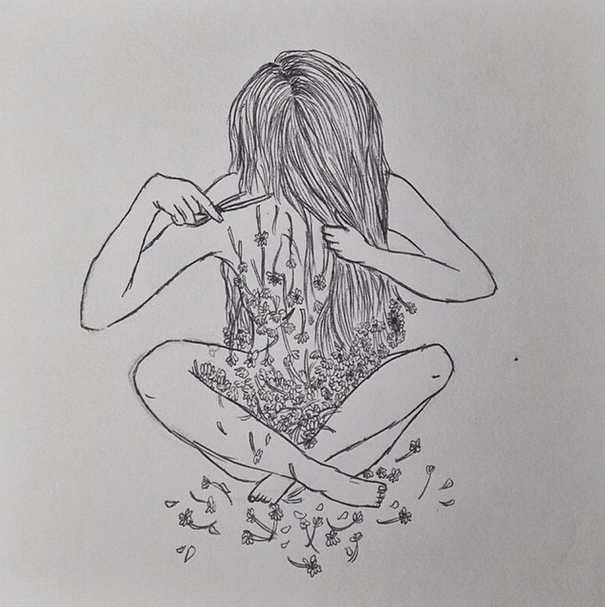In her seventeen years of life as they had so far been lived, Abigail Fountain came to learn there were exactly four things she absolutely could not stand:
1. Tomato sauce. Because really what was the point of some soupy version of a fine-enough vegetable? Or fruit. Or vegetable.
2. The ambiguous classification of the tomato. Whoever thought, years ago when the first tomato seed was planted in the ground that something so red and plainly round could cause such a fuss, would’ve been absolutely right and likely a magician of the future-fruit-vegetable-debate variety. (For reference, see Nix v. Hedden, 149 US 304 [1893], in which the Supreme Court of the United States arrived at the unanimous decision that despite any botanical classification stating otherwise, the tomato is, by law, a vegetable and not at all a fruit.)
3. Laws. Especially as they pertained to the categorization of tomatoes.
4. Haircuts.
And just because the first three items are tomato-based while the last one couldn’t be farther from that fruit-vegetable, it should still be considered just as significant a member on this list or any other detailing Abigail Fountain’s most-absolutely-can’t-stand things in life.
Here’s the truth: Abigail Fountain absolutely could not stand getting her hair cut.
Her mother had booked an appointment for such an egregious endeavor this afternoon and Abigail made it a point to walk the long-winded way through the city in order to show up at Bibsy’s Coifs ‘n’ Stuff too late and find that Mrs. Pimona Diddler, who went to Bisby’s every day, needed her hair colored a lighter shade of mud-brown right now.
No, Bibsy, I absolutely cannot wait forty-five minutes until Mrs. Diddler’s color sets. It happens I have another appointment one hour from the present moment and I absolutely must be on time. So, there we go, I guess we’ll try it once more next year. Take care and happy Sunday if any happiness exists among the rain.
Abigail slammed her left foot into a shallow puddle that had settled unceremoniously into a small dip of concrete sidewalk edging Bristol Road. Whenever possible, Abigail took the opportunity to make a splash.
Splash-making was the only way she knew to separate herself from the cluster of coagulated conformity found slouching into every plywood desk at Bridgeport High School. Abigail Fountain believed seventeen-year-old life only had sameness built into its teenage walls so that the person they contained could spend absolutely every minute in pursuit of knocking them down.
“We should dress in pajamas during the day and jeans to bed at night,” Abigail once told her only friend, Sandra O’Creppe who wore a neon pink string around her neck that clipped to the ends of her glasses and who transferred to a boarding school in Ontario, California last month.
In the farewell email Sandra wrote to Abigail, she mentioned her parents’ “concerns about a particular negative influence weighing on my better judgment and placing my future as a corporate lawyer in serious jeopardy,” which at the time, Abigail took to mean the entire eleventh grade. As a collective, the eleventh grade of Bridgeport High School had decided – and stuck to this decision the entire year – the correct pronunciation of Sandra’s last name was actually not O’Creppe but “Oh, crap!”
Never once did Abigail think anyone else might fall under the description of “a particular negative influence.” Without question, the phrase was a lightly veiled reference to the conformist crowd of Bridgeport High School, accepting their walls of sameness not as things to destroy but as boundaries to live inside, forever. This was the particular negative influence that forced Sandra to transfer schools. Absolutely.
With rain dribbling across Ermeyer Street, Abigail too dribbled her way toward Bibsy’s. The unfortunate dullness of intermittent droplets caused her to quicken her pace, and she scowled at her traitorous feet, which happened to take her to Bibsy’s Coifs ‘n’ Stuff absolutely on time.
“Hi Abby!”
Bibsy wore her usual all-black ensemble – a black sweater tucked into ashy black jeans – and Abigail knew she did it in the hopes of seeming much more posh and proper than her spikes of blue hair might allow or the nonsensical name of her salon might imply.
“Hello, Bibs.” Abigail made it a point to never call Bibsy by her full name if she couldn’t call Abigail by hers. Even if “Abby” wasn’t fully on Abigail Fountain’s list of absolutely-can’t-stand things in life, it came as close as anything could to joining its tomato and haircut brethren. “Sorry I’m late, Bibs, and if you have any other …”
“Oh, no no no,” Bibsy said in her Bibsy way, clipping the ends to every word like some haircutter of sound. “I’m ready for you right now.”
Abigail was shuffled over to what looked like a leather-covered highchair surrounded by tangles of wires from blowdryers, curlers and who knows what other shiny instruments of follicular torture.
Again, Abigail Fountain absolutely could not stand getting her hair cut.
So, she kept her eyes shut during the entire ordeal, imagining that each time Bibsy’s scissors tore at her hair, it wouldn’t fall to the ground in wisps of bygone blonde but as spring flowers, bright and alive.
This was absolutely the only way she could stand to sit through a haircut.
And before she could contemplate the status of that fruit-vegetable known as the tomato, it was over. Bibsy was sweeping a soft brush across Abigail’s neck and speaking in her usual staccato about how Gayle Fountain had placed a credit card on file so she shouldn’t worry her “cute, little seventeen-year-old self” about payment.
Then Abigail was back outside, walking unsteadily across Ermeyer Street and down Bristol Avenue, hoping the wetness might ruin whatever un-Abigail Fountain type hairdo Bibsy had doled upon her head. (She hadn’t looked in the mirror.) But even as she drew closer to home, Abigail felt something strangely akin to emptiness, like she needed some other can’t-stand-thing in her day just so it would sit there, lodged stubbornly between drops of spasmodic Sunday rain, forcing her to invent ways to avoid it. Because if she was ever going to break free from those seventeen-year-old walls of adolescent sameness, they first needed to exist. Absolutely.
[This tiny tale is part of an ongoing collaboration project called “little word art,” which partners my words with illustrations from talented artists around the country. The image featured in this story was created by Leigh Vossen. You can view more of her work here.]


